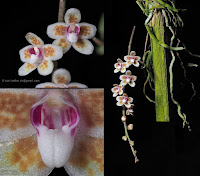[Most Recent Entries] [Calendar View]
Tuesday, March 5th, 2024
| Time | Event | ||||||
| 12:12a | [Botany • 2024] Begonia naraharii (Begoniaceae, sect. Platycentrum) • A New Species from Mishmi Hills of Arunachal Pradesh, India
Abstract A new species of the genus Begonia (sect. Platycentrum, Begoniaceae) from Mishmi Hills of Arunachal Pradesh, India, Begonia naraharii B.Hajong, N.Bhat & P.Bharali is described and illustrated. A detailed taxonomic description, accompanied by photographs, as well as notes on distribution, conservation status, and a table of comparisons with allied species, are provided. Key words: Begonia, Cucurbitales, Eastern Himalaya, Eudicots, Northeast India, Taxonomy
Begonia naraharii B.Hajong, N.Bhat & P.Bharali sp. nov. § Platycentrum Etymology: The species epithet “naraharii” honors Prof. Garikapati Narahari Sastry, Director of CSIR-North East
Institute of Science and Technology (NEIST), Jorhat, in recognition of his immense contribution to establishing the
Germplasm Conservation Centre for the Bioresources of Northeast India at CSIR-NEIST campus and his unwavering
commitment to improving the well-being of the people in the northeastern region of India. Bipankar Hajong, Nazir Ahmad Bhat and Pankaj Bharali. 2024. A New Species of Begonia (Begoniaceae) from Mishmi Hills of Arunachal Pradesh, India. Phytotaxa. 637(3); 285-290. DOI:10.11646/phytotaxa.637.3.7 | ||||||
| 5:56a | [Botany • 2022] Teuscheria falcon (Orchidaceae: Maxillariinae) • A New Species from Colombia
Abstract Teuscheria falcon Kolan., Szlach. & Medina Tr. sp. nova (Orchidaceae, Maxillariinae), is described from the Colombian Andes. It resembles T. cornucopia from which it differs by oblong obovate petals, the lip being wider than long, and by the obflabellate lip mid-lobe with a subhastate base that overlaps the basal part of the lateral lobes. Images of T. falcon are provided together with an identification key to the Colombian Teuscheria species. Marta Kolanowska, Dariusz L. Szlachetko and Ramiro Medina Trejo. 2022. Teuscheria falcon (Orchidaceae, Maxillariinae), A New Species from Colombia. Annales Botanici Fennici. 59(1); 295-301. DOI: 10.5735/085.059.0142 Falcon – New Orchid Species Dedicated to Ukraine | ||||||
| 10:18a | [Botany • 2023] Chiloschista shanica (Orchidaceae: Epidendroideae: Aeridinae) • A New Species from Myanmar
Abstract A new species of Chiloschista is described and illustrated from Myanmar (Shan State) with colour plates, line drawing and photographs. The comparison and differentiation are made with Chiloschista rodriguezii, C. parishii and C. lunifera. Chiloschista shanica is most similar to C. rodriguezii from which it differs in having brownish streaks on green coloured peduncle and pedicel, densely placed flowers on the peduncle; sepals and petals comparatively shorter and wider, white coloured dotted with reddish-brown spots and being glabrous on the outer surface; labellum sac pointing forwards; side lobes of labellum acute with denticulate margin and arching above the column and denticulate upper margin of rostellum. From C. parishii and C. lunifera the new species differs in having a deeply saccate labellum with hairs on its front and back wall and sepals and petals almost glabrous on outer surface. Chiloschista shanica K.P.Wojtas, C.Bandara & Kumar Etymology: Named in reference to Shan State of Myanmar from where the species was reported by Tun (2014) for the first time and is still believed to be endemic to. K. Philip Wojtas, Champika Bandara and Pankaj Kumar. 2023. A New Species of Chiloschista (Orchidaceae, Aeridinae) from Myanmar. Phytotaxa. 612(1); 57-66. DOI: 10.11646/phytotaxa.612.1.4 www.linkedin.com/posts/pankaj-kumar-p | ||||||
| 11:00a | [Botany • 2024] Thismia malipoensis (Thismiaceae) • A New Species of Thismia sect. Glaziocharis from Yunnan, China
Abstract Thismia Griff. (Thismiaceae) is a holo-mycoheterotrophic genus with more than 100 species. In this study, phylogenetic analyses supported that T. malipoensis from Yunnan is a new species in T. sect. Glaziocharis. Morphologically, this new species can be distinguished from its phylogenetic sister species T. abei by having the annulus of the flower expanded and modified into a cucullate (hood-like) structure with zygomorphic symmetry with one opening on one side. Biogeographical inference showed that SW China to Indo-Burma and the Sunda Shelf region was suggested as the ancestral distribution region of Thismia s.s., then eastward to SE China and Japan, and southward to New Guinea to Australia, respectively. The Chinese species should have originated from at least two different ancestral sources, and geographical isolation caused the divergence between T. malipoensis and T. abei at 17.47 Mya. KEYWORDS: biogeography, China, conservation, new species, phylogeny, taxonomy, Thismia, Thismiaceae
Thismia malipoensis J. D. Ya & W. B. Yu, sp. nov. Diagnosis — Thismia malipoensis belongs to T. sect. Glaziocharis and can be distinguished from its phylogenetic sister species T. abei by having the annulus of the flower expanded and modified into a cucullate (hood-like) structure with zygomorphic symmetry with one opening on one side. Moreover, T. malipoensis can be distinguished from the morphologically similar T. belumensis, in that the outer and inner tepal appendages are spreading (vs erect) and equal in length by less than 2 cm (vs outer tepal appendage 1.5–2.5 cm and inner tepal appendage c. 3 cm), the inner tepal base is fimbriate at the margin (vs entire) and the inner tepal tip is subulate (vs clavate). Etymology — The specific epithet “malipoensis” refers to the county name Malipo of Wenshan Prefecture, the type locality of the new species. Chinese name — 麻栗坡水玉杯 (má lì pō shuǐ yù bēi). Ji-Dong Ya, Hai-Yao Chen, Wei Zhang, Ren-Bin Zhu, Jie Cai and Wen-Bin Yu. 2024. Phylogenetic and Biogeographical Analyses of Thismia (Thismiaceae) support T. malipoensis as the eighth species in China. Willdenowia. 54(1); 47-63. DOI: 10.3372/wi.54.54102 twitter.com/thismiaguy/status/176316800 |
| << Previous Day |
2024/03/05 [Calendar] |
Next Day >> |














